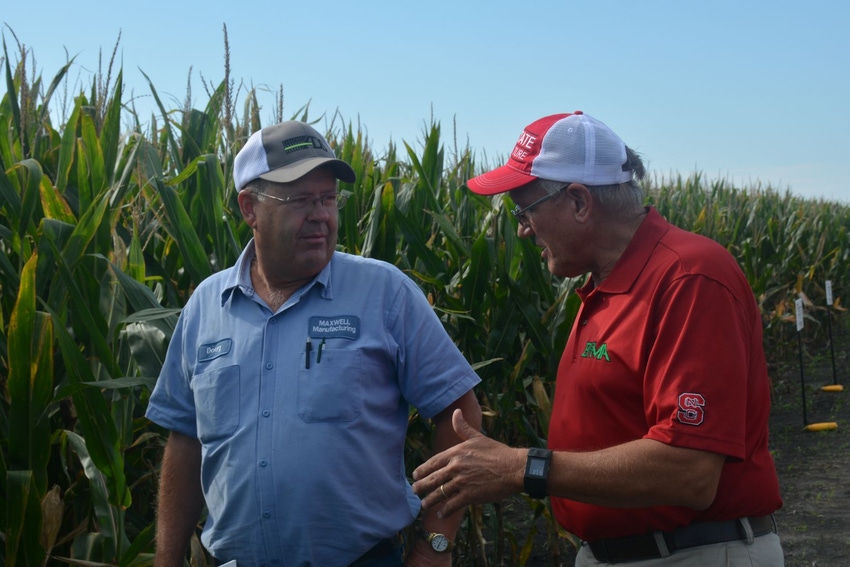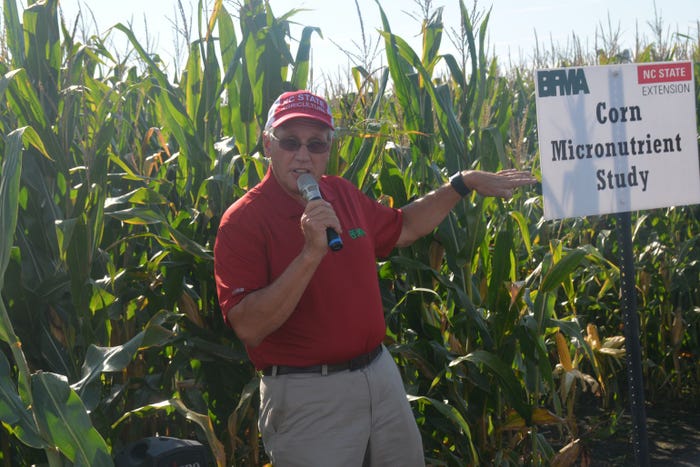
To achieve banner yields, successful corn farmers manage fertility.
Ron Heiniger, North Carolina State University Extension corn specialist, explains that there are two things farmers need to do to manage fertility:
Understand how much nutrients they have in their soil.
Manage nutrient uptake to the corn plants.
Soil sampling to discover how many nutrients you have in your soil and understanding how your soil reacts to those nutrients is critical. The more difficult task is managing nutrient uptake.
Speaking at the Blacklands Farm Managers Tour at Green Valley Farms in Columbia, N.C. Aug. 2, Heiniger said farmers need to know how many of the nutrients in the soil profile actually make it into the corn plant.
“It doesn’t take you very long to look at a corn root system and realize it doesn’t go down very far,” Heiniger said. This presents a particular challenge for elements that don’t move very much, such as phosphorous and potassium.
Root mass
The first step in managing nutrient uptake is to manage the size of the root mass. “The bigger root mass you can have, the more area of soil it explores, and the more nutrients you are going to make available,” Heiniger explained. “Root mass is made in the early part of the season. By the time you get to V10 or V12, most of the root mass is made.”
Farmers need to make sure that the fertilize they apply is making it into the tissue of the corn plant and this is particular important for phosphorous. Heiniger is conducting research at Green Valley Farms and at other locations across North Carolina to determine if there are ways to enhance phosphorus availability.
He said starter fertilizer is important in enhancing root growth and additives that improve nutrient uptake can help enhance phosphorus availability. Moreover, Heiniger said micronutrients such as zinc, magnesium and boron are essential to the corn plant because they are important for enhancing plant growth and nutrient uptake .
“Boron is mobile in your soil. If we get a seven-inch or eight-inch rain or maybe a five-inch or six-inch rain, boron moves, just like nitrogen and sulfur, down into the profile. It’s easy to get boron below where the root can intercept it. That’s a problem,” Heiniger said.
In his research this year, Heiniger added boron, zinc and magnesium at V3 and V6. He also applied a half pound of boron per acre and 3/4th of a pound of zinc at planting. He is comparing the results to a plot where these micronutrients weren’t applied.
“One of the things I’ve seen in this plot is, boy, these nutrients added at planting sure do look like they’re making a difference. Boron influences kernel set,” he said.
The micronutrients added at V3 and V6 appear to be making a small difference. “It will be interesting to see when the combine comes through to see if it put out enough ears to make a difference,” Heiniger said.
Boron deficiency isn’t seen until the end of the season when corn ears aren’t as big as they should be. “Potassium, sulfur and magnesium can all be deficient when we don’t have sufficient boron at V3,” Heiniger said.
“For high-yield corn, we have to manage our balance of nutrients, particularly micronutrients,” Heiniger said. “When we talk about high-yield corn we have to manage water and the environment to push the population and fill that ear. We need to look at micronutrients as an essential component in that system.”

Speaking at the Blackland Farm Managers Tour, Ron Heiniger said farmers need to understand how many of the nutrients in the soil profile actually make it into the corn plant.
.
About the Author(s)
You May Also Like






